Difference Between Real and Virtual ImageThe method by which how it is created distinguishes a real image from a virtual one. Light beams must converge to create a real image, whereas they must diverge to create a virtual image. Let's examine the distinction between a genuine image and a virtual image. 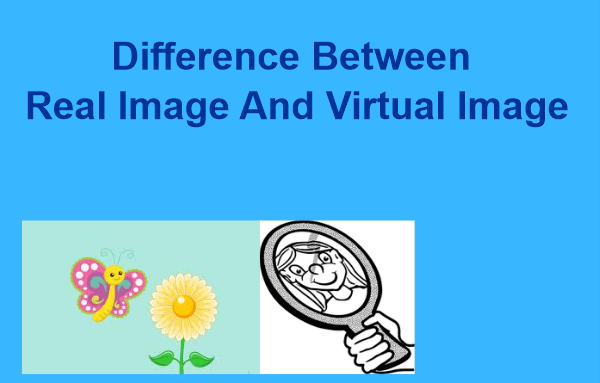
What is a Real Image?Real pictures are created when light beams refracted or reflected by a mirror or lens clash at a particular spot. The definition states that a real image is produced when light beams are directed at a definite location. As a result, the light source and the screen must be on the same plane for a real image to be created. On a screen, we can get a true image. We may use a converging lens or a concave mirror to create the image. Real visuals appear inverted on the screen just as they do in life. When several light beams hit the mirror, they will all reflect again and come together at a place in front of the mirror by obeying the principles of reflection. A visible image of the object is generated at the location where light rays are concentrated or focused. The fact that the beams deviate from their point of convergence is significant to remember. In other words, it is a picture situated in the plane where the light rays from a specific object converge. Real images include, for example, those produced on the retina of the eye and those produced on a camera's back detector (the camera and eye focus light through an internal convex lens). Real rays of light are consistently depicted in ray diagrams by full, solid lines, while dashed lines depict perceived or extrapolated light rays. In a virtual image, rays seem to diverge, but they converge in a real image. As an object moves past the focal point, the picture becomes virtual, is not inverted, and approaches infinity as the item moves towards the focal point (upright image). A large distance separates the subject and the lens. When the item is placed farther away from the mirror or lens than the focus point, concave mirrors and converging lenses can produce genuine images, which are then reversed. 
We may use an additional lens or lens system to examine actual images. The objective lens within the optical device gathers light from the subject and creates an accurate image. A second genuine image is then projected onto the eye's retina by a second lens or group of lenses, the eyepiece. What is a Virtual Image?When light beams are refracted or reflected by diverging, a virtual image is created. Virtual images only seem to form when viewed from behind a mirror. An image that we cannot obtain on a screen is a virtual image. We can utilize a convex mirror or a diverging lens to create a virtual image. When a mirror is exposed to light from an object, light beams reflect off of it and appear to be separating behind the mirror. Since there is no light behind the mirror, the viewer's perception causes the rays to appear to meet somewhere. The screen doesn't show any virtual images. The fact that virtual visuals are real is another crucial point. Because virtual images have specific sizes and shapes, we can perceive them with our eyes or with any other optical device. The plane mirrors' generated pictures are specifically of the virtual type. A collection of focus points for light rays emanating from an object constitutes a picture in optics. A virtual image has focus points created by extensions of diverging rays, whereas a real image has focus points created by converging rays. In other words, a virtual image is created by following actual rays that leave an optical device (such as a lens, mirror, or combination of them) back to their seen or apparent points of origin. Virtual rays are typically shown in optical system diagrams as dotted lines instead of the solid lines of actual rays. Projecting a virtual image onto a screen is impossible since the rays never converge. In contrast, we can project a real image created by rays converging on a real spot onto a screen. We can project an actual image onto a diffusely reflecting screen to make it visible to the general public (the image on the screenplays as an object to be imaged by human eyes). A plane mirror behind the mirror casts a virtual picture. Despite appearing from behind the mirror, the light's source is only visible in front of the mirror. In a plane mirror, the image is not enlarged (i.e., it is the same size as the item), and it appears to be equally distant from the mirror as the object is from it. 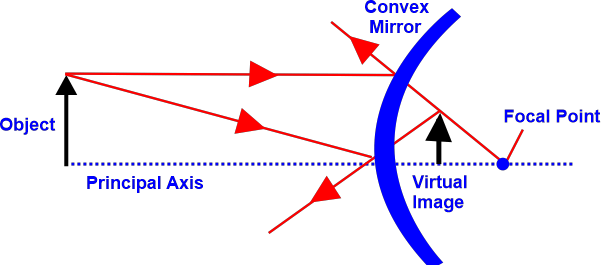
A virtual picture is created using a convex mirror or a diverging lens, thicker at the edges than the centre. Comparing the size of the image to the original object, it is smaller. If the item is within the focal length, a converging lens thicker in the centre than the edges or a concave mirror can create a virtual image. We'll make the image larger. On the other hand, when an object is positioned in front of a converging lens or concave mirror at a distance beyond the focal length, a genuine image is created. If the object is within two times the focal length, we will magnify the image, otherwise, if the object is farther away than two times the focal length, we will shrink the image. It is accessible on a screen. A virtual image cannot be made visible on a screen, for example, a piece of paper, whereas a real image has light rays focused on the image's position. Images captured by a camera lens are examples of genuine images. Their respective distances separate the object and image from the lens. Similar to how it is applied in the case of mirrors, a positive image distance refers to an actual image. A true image must be in front of a mirror or behind a lens, where the light is, as you can recall if you carefully think. Contrarily, a positive image distance means that the image is located on the side of the object unaffected by the lens. Diverging lenses or positioning an object inside a converging lens's focal length can create virtual images. For the case of a virtual image, the ray-tracing operation is repeated. The virtual image, in this instance, is vertical and scaled down. Only in this instance the focus length and the image distance solution is low. Converging lenses can also create virtual images when the item is positioned inside the focal length. Since it will be farther away from the lens than the object in that scenario, the virtual picture will be upright and expanded. The Key Distinction between a Virtual Image and a Real ImageAfter learning the distinction between a real and a virtual image, it is crucial to properly understand these two types of images. The hypothetical intersection of light beams produces a virtual image, whereas the actual junction of light rays produces a real image. We can only view a virtual picture in the mirror but we can create a genuine image on a screen. This article will examine additional distinctions between actual visuals and virtual images. Tracing actual rays that exit an optical device backward to their observed or apparent sources of beam divergences yields a virtual image. Either a converging lens or a concave mirror can be used to capture the images. Projecting a virtual image onto a screen is impossible since the rays never converge. The real image will benefit over a virtual image, thus lies in the fact that the former may be obtained on a screen while the latter cannot. 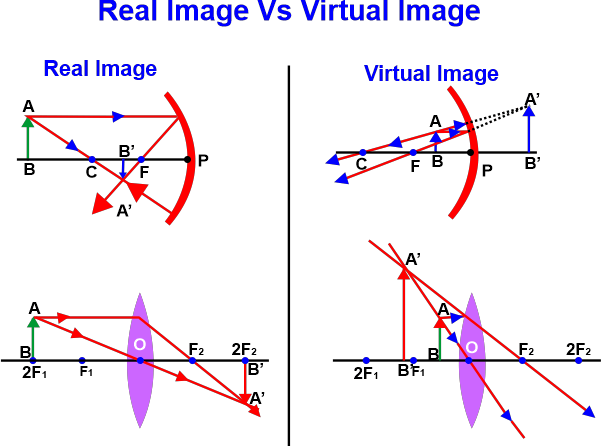
Two categories of formed images are Real Pictures and Digital images. Do you understand the importance of these pictures and how they differ? We may learn about the various kinds of mirror images and their distinctions from this page. Concave and convex mirrors reveal differences between real and virtual images. Let's examine the differences between actual and virtual images now: In terms of optics, an image is a collection of focus locations for light rays emitted from an object. A real image is the collection of focus points actually made by converging rays. A genuine picture represents an item in the plane of convergence of the light rays coming from it. Real images happen when the rays come together, but virtual images happen when the beams appear to diverge. Using concave mirrors and converging lenses, a real image can be produced by inverting the real image and positioning the object farther away from the mirror/lens than the focal point. As the object moves closer to the focal point, the image will move towards infinity, after it has passed the focal point, it will become virtual and upright. Space is distinct from the separation between the object and the lens. 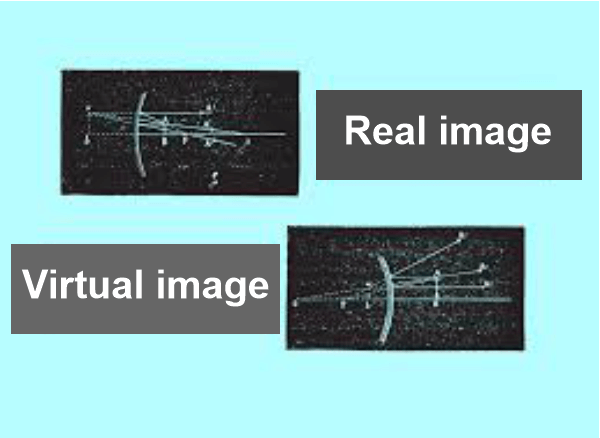
An actual image can be projected onto the screen when light rays that have undergone reflection or refraction collide at that location. A virtual image, one that does not exist in reality, shows the backward extension of light beams that have been refracted or reflected. A convex lens will produce a realistic image when you set an object at or close to a distance equal to or less than the focal length. This is comparable to what you would see in a concave mirror, except that you will see an actual image of the object if it is placed at or near the focal point. An example of a real image is the image on the movie screen while the object is projected with a projector is the most typical example of a true image. This replicates the screen image, which the human eye is meant to view. The retina of the eyeball or a detector at the back of a camera produces the image (they focus light through an internal convex lens). Real light rays are shown in full solid lines in the diagrams below, while generalized light rays are shown in dashed lines. Difference between Pictures Created by Spherical Mirrors that are Real and VirtualIt is possible to project or view a genuine image on a screen. A true image is created when light rays focus on a specific place. The best representation of a real image is produced on a movie screen. 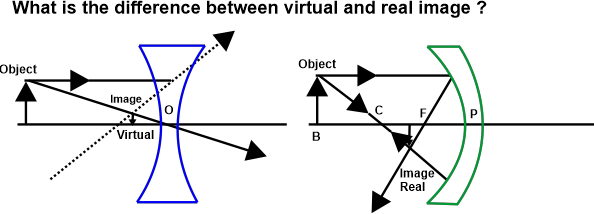
Since a virtual image is the opposite of a real image, we refer to an image we cannot obtain on a screen as a virtual image. Since the light rays that make up a virtual image never converge, this cannot be explained by the fact that we can never project a virtual image onto a screen. The best example of a virtual image is your reflection in the mirror. Diverging beams produce virtual images, but intersecting rays provide actual images. Virtual images cannot be projected on a screen, only real ones can. Concave and convex lenses placed in opposition create real images. Real images are constantly inverted, whereas virtual images are always upright. FAQsWhy am I unable to see a computer-generated image? The answer is that light rays must focus on a screen to produce an image. There are no genuine light beams that converge at the place of the virtual image in reality. At that moment, we can state that they cannot reflect on a screen. A movie projector creates accurate visuals. Why is it not upside down? A movie projector makes use of two mirrors. They focus the light source with the first mirror and focus the images on the screen with the second mirror. The final photos are upright as a result of the double inversion.
Next TopicDifference between
|
 For Videos Join Our Youtube Channel: Join Now
For Videos Join Our Youtube Channel: Join Now
Feedback
- Send your Feedback to [email protected]
Help Others, Please Share










